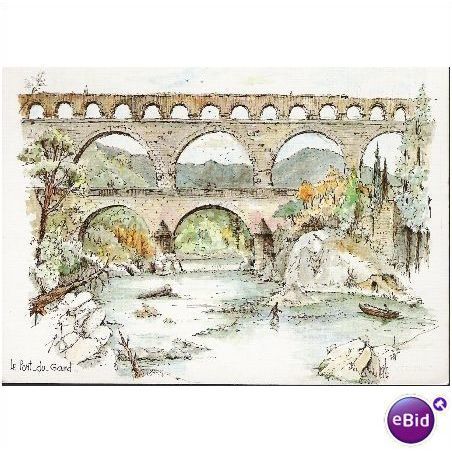Pont du Gard Roman aqueduct France art card 1970s
- Condition : Used
- Dispatch : 2 Days
- Brand : None
- ID# : 47514891
- Quantity : 1 item
- Views : 343
- Location : United Kingdom

- Seller : justthebook (+1703)
- Barcode : None
- Start : Fri 08 Jul 2011 12:46:35 (BST)
- Close : Run Until Sold
- Remain : Run Until Sold
More Listings from This Seller view all
Seller's Description
- Postcard
- Picture / Image: Le Pont du Gard, aquarelle originale de Robert Lepine
- Publisher: Yvon Paris
- Postally used: no
- Stamp: n/a
- Postmark(s): n/a
- Sent to: n/a
- Notes & Key words:
------------------------------------------------
Postage & Packing:
UK (incl. IOM, CI & BFPO): 99p
Europe: £1.60
Rest of world (inc. USA etc): £2.75
No additional charges for more than one postcard. You can buy as many postcards from me as you like and you will just pay the fee above once. (If buying postcards with other things such as books, please contact or wait for invoice before paying).
Payment Methods:
UK - PayPal, Cheque (from UK bank) or postal order
Outside UK: PayPal or Google Checkout ONLY please. NO non-UK currency checks or money orders (sorry).
NOTE: All postcards are sent in brand new stiffened envelopes which I have bought for the task. These are specially made to protect postcards and you may be able to re-use them. In addition there are other costs to sending so the above charge is not just for the stamp!
----------------------------------------------
Text from the free encyclopedia WIKIPEDIA may appear below to give a little background information:
*************
The Pont du Gard is an aqueduct in the South of France constructed by the Roman Empire, and located in Vers-Pont-du-Gard near Remoulins, in the Gard département.
Pont du Gard means literally bridge of the Gard (river). The Gard River, which has given its name to the Gard département, does not actually exist under this name. The river, formed by many tributaries, several of which are called Gardon, is itself called Gardon until its end.
It has long been thought that the Pont du Gard was built by Augustus' son-in-law and aide, Marcus Vipsanius Agrippa, around the year 19 BC. Newer excavations, however, suggest the construction may have taken place in the middle of the first century A.D; consequently, opinion is now somewhat divided on the matter. Designed to carry the water across the small Gardon river valley, it was part of a nearly 50 km (31 mi) aqueduct that brought water from the Fontaines d'Eure springs near Uzès to the Castellum in the Roman city of Nemausus (Nîmes).[1]The full aqueduct had a gradient of 34 cm/km (1/3000), descending only 17 m vertically in its entire length and delivering 20,000 cubic meters (5 million gallons) of water daily.
It was constructed entirely without the use of mortar. The aqueduct's stones – some of which weigh up to 6 tons – were precisely cut to fit perfectly together eliminating the need for mortar. The masonry was lifted into place by block and tackle with a massive human-powered treadmill providing the power for the winch. A complex scaffold was erected to support the aqueduct as it was being built. The face of the aqueduct still bears the mark of its construction, in the form of protruding scaffolding supports and ridges on the piers which supported the semicircular wooden frames on which the arches were constructed. Various inscriptions are found across the surface, containing instructions used in construction. For example, "FRS II" (frons sinistra II, Latin for "left face 2"), phallic symbols (intended to ward off bad luck), and graffiti left by builders throughout the ages.
The upper levels of the bridge are slightly curved in the upstream directions, a fact long attributed to the engineers wanting to strengthen it against the flow of water, like a dam wall. However, a microtopographic survey carried out in 1989 showed that the bend is caused by the daily expansion and contraction of stones under the heat of the sun, by about 5 millimetres. Over the centuries, this process has produced the deformation witnessed now.
It is believed to have taken about three years to build, employing between 800 and 1,000 workers.
Listing Information
| Listing Type | Gallery Listing |
| Listing ID# | 47514891 |
| Start Time | Fri 08 Jul 2011 12:46:35 (BST) |
| Close Time | Run Until Sold |
| Starting Bid | Fixed Price (no bidding) |
| Item Condition | Used |
| Bids | 0 |
| Views | 343 |
| Dispatch Time | 2 Days |
| Quantity | 1 |
| Location | United Kingdom |
| Auto Extend | No |




 for 1 item(s)
for 1 item(s)











